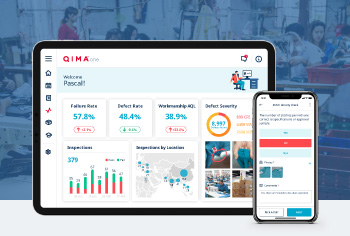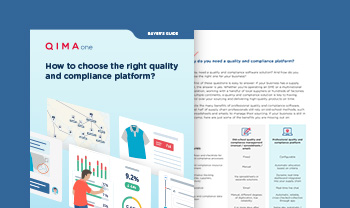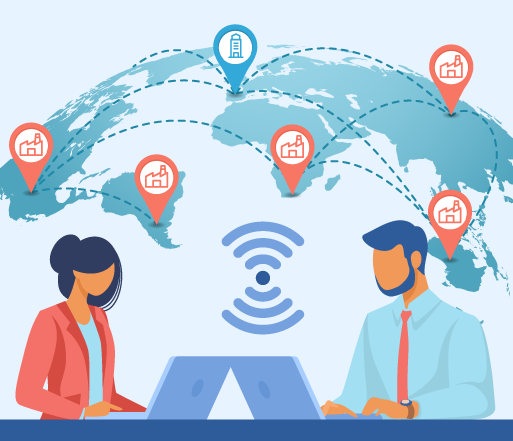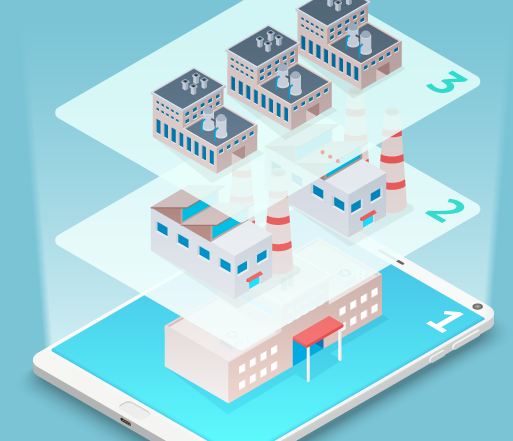
Articles
Supply Chain Visibility: Complete Guide for Supply Chain Managers

Articles
Supply Chain Visibility: Complete Guide for Supply Chain Managers
Articles
Supply Chain Visibility: Complete Guide for Supply Chain Managers

随时了解最新的供应链信息。
Brands that achieve end-to-end supply chain visibility have a competitive advantage over those that don’t in multiple ways. Success stories from companies like Guess and IKKS, who have adopted SCV techniques, have pushed other organizations of all sizes to gain more visibility within their own supply chains so they can reap similar benefits.
This article will explain how SCV works, the benefits it brings, and challenges in attaining it.
Key Takeaways
- Supply chain visibility helps you:
- keep track of all stages of your supply chain, including external suppliers and distributors.
- Prevent product quality and compliance issues, helping to avoid disruptions and ensure customer satisfaction
- Monitor supplier performance with actionable metrics like the failure rate, defect rate, and more
- Make faster, more informed decisions leading to more efficiency and profits
- Software solutions like supply chain quality management platform powered by actionable data insights can help to achieve an end-to-end supply chain visibility
What Is Supply Chain Visibility?
Supply chain visibility (SCV) refers to the ability of a company to track its products through each step of their supply chain, from source to shelf. The primary goal of supply chain visibility is to increase the understanding of how your supply chain is functioning at every stage. SCV helps you reduce risks and optimize operations to improve your product quality and compliance, reduce disruptions, and increase efficiency and profits.
Supply Chain Visibility Issues: Challenges of SCV and Why SCV is Necessary
The major challenges in supply chain visibility stem from difficulty in getting the right data, organizing the data, and analyzing it properly and quickly. Today, most supply chains are globalized, which can make it difficult to achieve proper data collection, management, and analysis. Even the majority of small businesses have their supply chain spread across multiple countries or even continents. Brands and retailers with global supply chains, even the smaller ones, often lack the oversight resources to keep an eye on the whole process.
In general, it can be difficult to ensure full transparency and visibility across such dispersed supply chains. There are several challenges that hinder effective supply chain visibility. These challenges, listed below, lead to disruptions that can be avoided through the implementation of a strong supply chain visibility platform.
- A lack of communication across the network: With so many different stakeholders within a supply chain, it is difficult to ensure smooth communication throughout. Smooth collaboration is a crucial aspect of visibility, as it allows for an informed supply chain in which no stakeholder is blindsided by problems occurring in another stage of the supply chain. Moreover, the collaboration between supply chain partners should rely on shared data and goals. Businesses need to foster a culture of quality excellence and accountability into their supply network.
- Different management systems for different partners: Each stakeholder in the supply chain likely has a different style of supply chain management. For example, some suppliers may be using different processes, metrics or different software to manage quality or measure performance. With different management systems in place, it is difficult to consolidate data and to understand the full picture. Having a centralized supply chain visibility platform where all partners have access to reliable information that can be discussed in real time is one of the keys to success.
- A lack of performance tracking across the supply chain: As each stakeholder is ultimately responsible for its own operations, sometimes tracking between different suppliers in the supply chain falls through the cracks. Being able to monitor performance metrics such as failure rate, visual defects, measurement deviations or audit scores over time can help you anticipate disruptions. Supply chain quality and visibility management software with a strong risk mitigation tool brings more transparency into the key metrics to monitor across the supply chain.
- Unorganized data: The last challenge of supply chain visibility is actually having too much data that is information poor. While having more information is a primary goal of supply chain visibility, large amounts of data can be overwhelming, and are useless if not analyzed or communicated correctly. Companies must put in place a strong data collection framework to make sure the information collected on the factory floor is trustworthy and standardized. Companies can then turn this raw data into actionable insights. Feeding large amounts of reliable data to a supply chain visibility software powered with machine learning capabilities provides a huge advantage in detecting issues before they occur.
Read more: Challenges and Solutions for Supply Chain Visibility
The 4 Advantages of Supply Chain Visibility
Achieving supply chain visibility increases your control over operations, reducing risk and fostering sustainable growth. Generally, SCV is more applicable to larger companies and more complex supply chains, but small companies seeking to grow also benefit from incorporating these practices into their operations.
1. Data-informed decision making
An effective SCV system increases the amount and quality of data within your supply chain. When analyzed effectively - and often in real-time - this data can help you to make adjustments better and quicker than your competitors. For instance, being able to diversify your sourcing footprint in case of external crisis and onboard new factories with standardized processes and streamlined inspections thanks to digital solutions.
SCV helps companies keep track of:
- Raw material sourcing, such as where the materials are sourced and in what conditions they are produced
- Supplier performance, including compliance with manufacturing and product quality standards as well as ethical and environmental requirements
- Inspector integrity, including the time spent by inspections, the factory location and the average deviations for measurements for instance
While increased visibility within the supply chain does provide more data, large amounts of data can be overwhelming and are not useful without effective management and analysis. Many companies employ supply chain visibility software to collect and analyze this data, and to inform management decisions moving forward. Some companies may use disparate spreadsheets to collect, store and analyze data. However, working with manual spreadsheets and emails is the slowest way to leverage your supply chain data and make decisions. Organizations that can collect, organize, and analyze their data more effectively have an advantage over their competitors because they can react faster to disruptions and anticipate risks.
Finally, supply chain visibility allows you to share data and increase collaboration across the supply chain. Keeping all stakeholders in the supply chain informed helps to predict or react to problems in a strategic manner and ensure goods are in the right place at the right time.
2. Decreased supply chain disruptions
SCV helps supply chain managers spot potential issues, such as poor quality practices, unauthorized subcontracting and unethical sourcing. Additionally, understanding a partners’ reliability, vulnerabilities, and historical record further enable you to be proactive about identifying and fixing problems. Increased data sharing allows you to find and fix small problems before they grow into disruptions.
Supply chain visibility can also ensure adherence to labor standards or sustainability practices throughout the supply chain. By increasing awareness of stages of the supply chain that are falling behind in ethical or environmental goals, you increase your ability to respond to these issues, avoiding regulatory intervention and recalls.
3. Increased efficiency
Supply chain visibility allows you to make faster, more informed decisions because you have better information to evaluate. Visibility into all areas of your supply chain can help you detect and pinpoint inefficiencies in areas you would have previously overlooked. Small efficiency adjustments across your supply chain compound over time to have a significant impact on final quality and costs. For quality control (QC) leaders, having complete visibility into the inspection process with the tool to monitor each checkpoint can help them save up to 50% of their time managing QC reporting.
4. Increased customer satisfaction
Companies that have supply chain visibility are better at responding to shifting customer demands than those who don’t. SCV helps achieve customer satisfaction by helping ensure consistent product quality and compliance. As discussed above, SCV helps catch major defects earlier in the process, reduces supply chain risks, and ensures your suppliers maintain ethical and environmental standards. All of these factors are crucial parts of meeting customer expectations.
Additionally, supply chain visibility creates data insights that may reveal larger trends in product quality over time that may not be obvious from a single snapshot in time. These trends can help you identify and prioritize your highest performing suppliers.
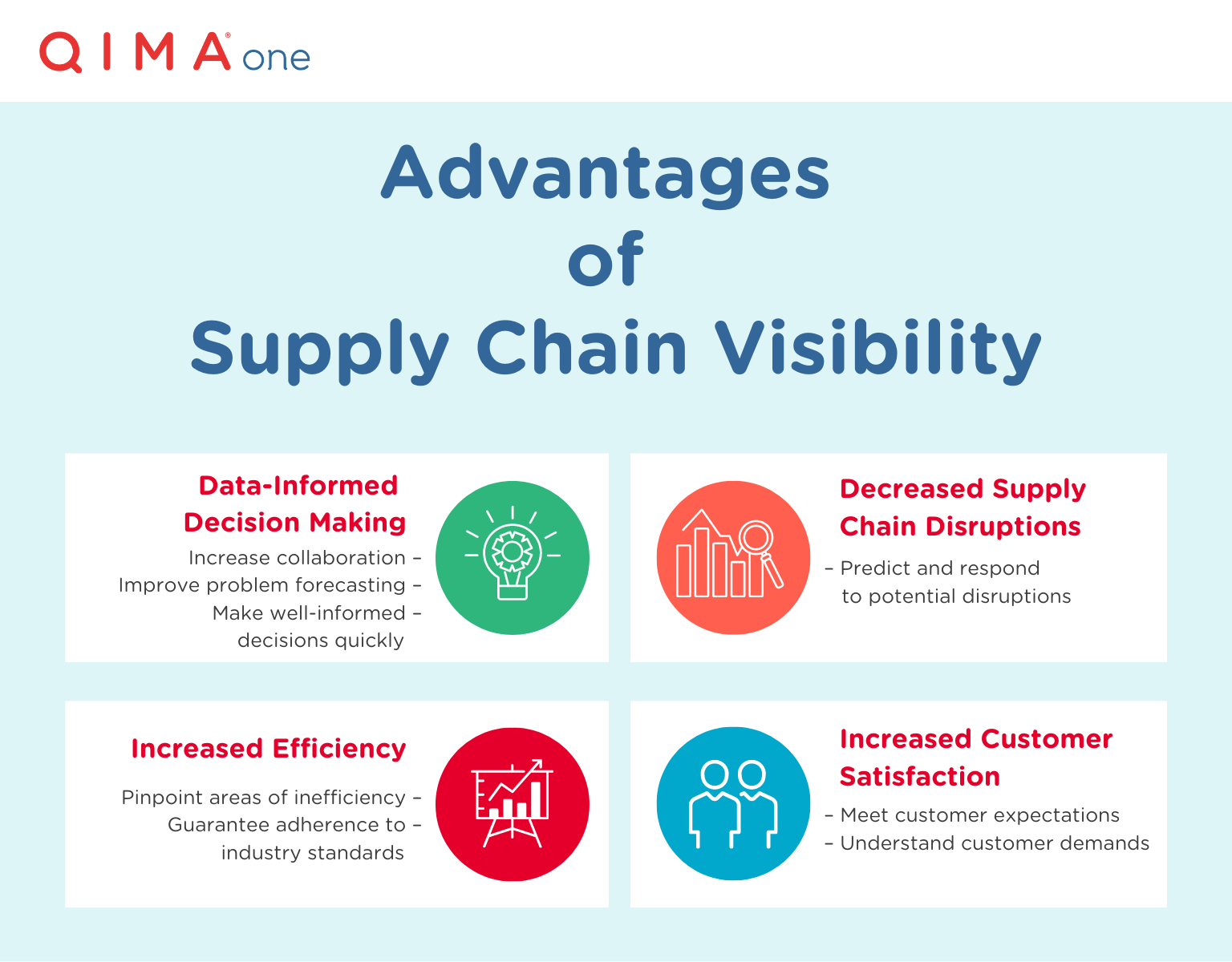
Read more about the advantages of supply chain visibility:
Types of Supply Chain Visibility Management
There are several types of supply chain visibility, including multi-tier, real-time and end-to-end. Each type of supply chain visibility has different benefits, as each provides a new framework for managing visibility or focuses on a different stage of the supply chain. Companies may benefit from employing multiple types of supply chain visibility management, as each type provides new insights that cumulatively provide a clear picture of your supply chain’s operations.
In this section, we’ll discuss multiple types of supply chain visibility to help illustrate the key differences and benefits of each.
Multi-Tier Supply Chain Visibility
Multi-tier supply chains are challenging because there are so many stakeholders involved at different stages of the supply chain. Your company may have visibility of your direct tier 1 suppliers, but it can be difficult to trace relationships farther back in the supply chain, particularly if each stakeholder is using a different management system. Employing a system to ensure multi-tier supply chain visibility helps reduce the challenges that come with a dispersed, broad network of suppliers.
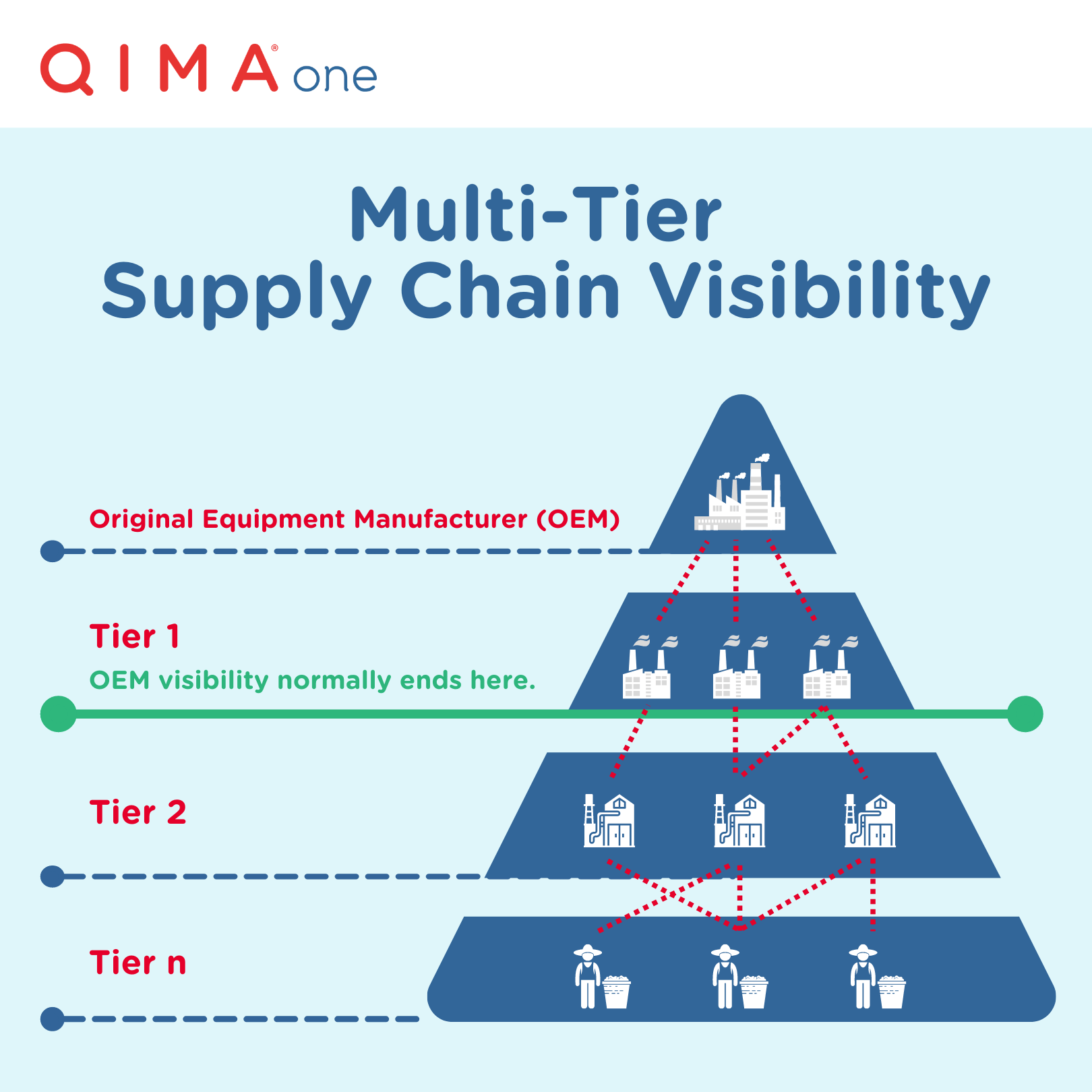
Multi-tier supply chain visibility is achieved when your company gains visibility through the entire upstream supply chain (each of the previous tiers). Visibility in every tier of the supply chain has many benefits. These include:
- Lowered risk through increased knowledge of potential disruptions
- Increased communication across tiers, which allows for rapid responses to changes or problems
- Profit increases through optimizing your operational costs and reducing returns
- Increased understanding of supplier performance, which allows you to prioritize high-performing, dependable suppliers
Multi-tier supply chain visibility allows managers to understand which parts of their supply chain they can influence and manage directly (such as the stakeholders they have direct contact with, direct contracts with, or direct payments to) and which parts they have no direct influence on, such as suppliers and manufacturers at the second tier. For example, a multi-tier supply chain may be built in such a way that your company has direct contracts with all the suppliers at different tiers, and hence may manage relationships with them directly. On the other hand, in some multi-tier supply chains, only suppliers at neighboring tiers have direct contact, which reduces the ability of your company to optimize the process as a whole. In this case, having visibility at every stage of your supply chain can help build trust with your direct contacts while keeping control on how their suppliers are manufacturing your goods.
Real-Time Supply Chain Visibility
Real-time supply chain visibility is the gathering of “live” information, or data on what is happening in your supply chain at this very moment. Real-time supply chain visibility helps you understand the status of each stage of your supply chain and any new conditions or problems that may arise. Understanding what’s occurring in real time is crucial to catching potential issues before they cause disruptions.
Real-time supply chain visibility is most commonly managed with the use of GPS-tracking and management software. This allows you to track goods and services in real time and monitor logistics throughout the supply chain. This includes tracking shipments, the procurement of raw materials, and order statuses. Benefits of real-time supply chain visibility include:
- On-time deliveries, which help maintain customer relationships
- Increased profits through efficient use of resources and a lack of wasted resources
- Reduced costs through early warning of unpredictable variables that impact transportation such as traffic or weather.
- Compliance with regulatory requirements throughout the supply chain such as import and export requirements
End To End Visibility in the Supply Chain
End to end visibility in the supply chain refers to supply chain visibility throughout the entire supply chain, from the sourcing of raw materials to the delivery of the final product to customers. End to end (E2E) supply chain visibility is one of the most all-encompassing forms of supply chain visibility, as it includes gathering data from every single aspect of the supply chain, including stakeholders both upstream and downstream. This includes oversight in several areas, including:
- Inventory management
- Finance
- Logistics
- Operations
- Quality control
- Sales
End to end supply chain visibility is quite similar to multi-tier visibility, as it applies to the entire supply chain. However, multi-tier visibility provides the framework of “tiers,” rather than areas of focus.
End to end visibility allows for communication across each area in order to avoid interruptions and reduce inefficiencies. For example, it is crucial that those in charge of logistics are in touch with inventory managers in order to shift logistical plans in the event of an inventory shortage. End to end visibility allows for evaluation of the supply chain as a whole. End to end visibility provides:
- Increased planning abilities
- Increased accuracy of reporting
- Improved customer experience
- Fewer disruptions
- Increased control over inventory, which helps reduce costs
Many companies use supply chain management software to implement end to end supply chain visibility, as this allows for coordination across multiple operational areas both internally and externally.
How to Improve Supply Chain Visibility to achieve quality excellence
There are a few steps you can take to improve visibility in your supply chain. Before embarking on these steps, however, it’s important to define your supply chain visibility goals by assessing which areas of your supply chain are a priority for monitoring.
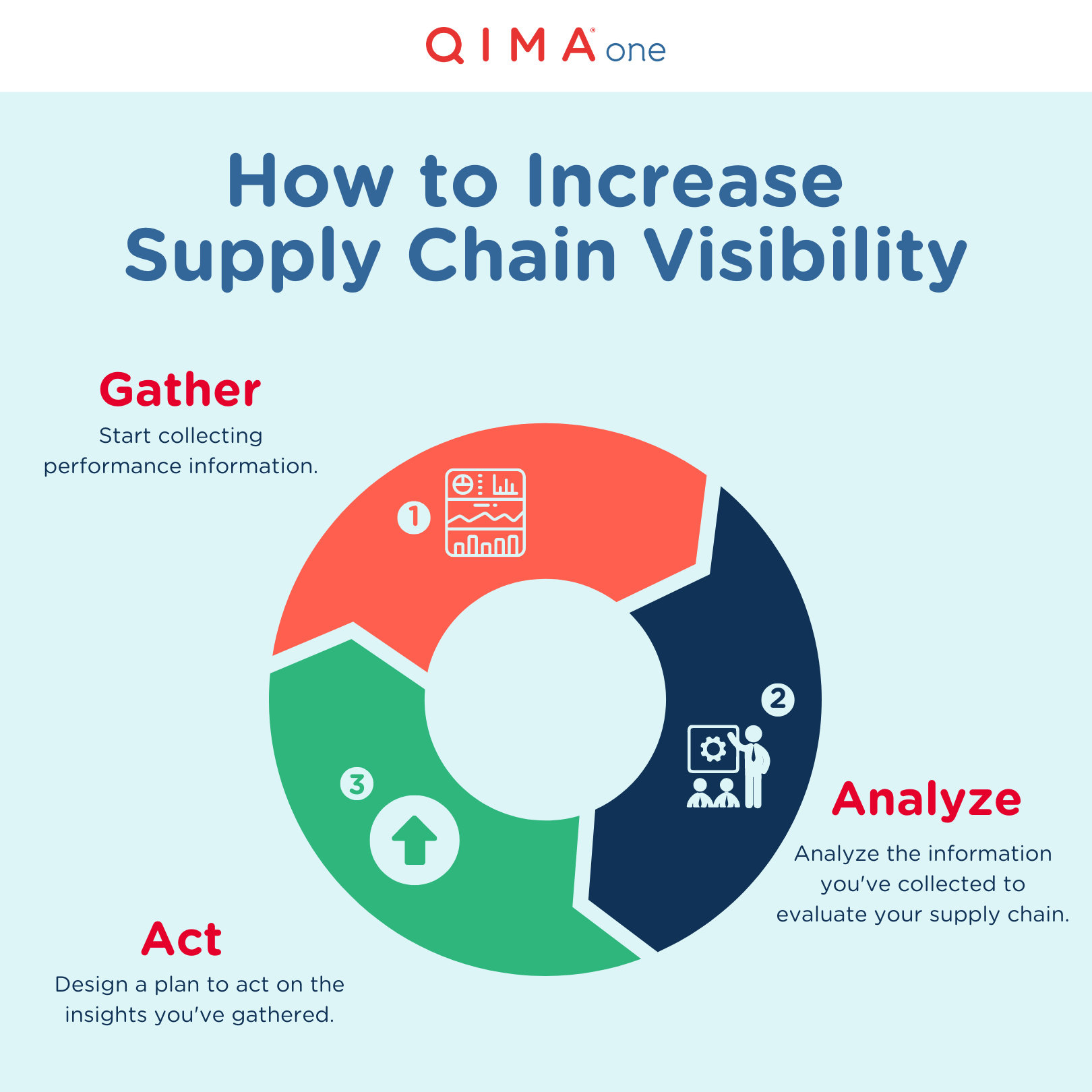
- Gather data. The first step to improve supply chain visibility is gathering data. Data must be gathered from every stakeholder in the supply chain. Much supplier data can be gathered via audits, inspections, and lab tests. Many companies rely on supply chain quality and compliance management software to monitor and standardize reporting and to share information across the supply chain.
- Analyze the data. After you’ve gathered information about how your supply chain is working, you must analyze it to evaluate your supply chain process. This includes evaluating whether everyone in the supply chain is receiving the information they need, as well as assessing the process for wasted or untapped resources. Supply chain quality control management software helps you analyze data, as it provides actionable insights into trends in your supply chain and areas for improvement. Supply chain quality control management software can help manage supplier relationships and ensure production adheres to the correct schedule and quality standards. Software can also help automate operational processes such as inspection booking, or tracking corrective actions.
- Act on the data. Finally, create a plan to act on the insights you’ve gathered. This may include:
- developing more thorough control or monitoring procedures,
- eliminating low-performing suppliers,
- increasing communication throughout the supply chain,
- putting self-inspections in place with your trusted factories
- shifting your transportation routes, or any number of other efficiency-boosting actions.
Examples Of Supply Chain Visibility
Businesses in a wide variety of industries are reaping the benefits of improved supply chain visibility. Here are a few examples.
Guess Increases Product Quality and Efficiency
Major luxury fashion brand Guess does not own factories, and instead partners with global suppliers in over 30 countries, which can make tracking across the supply chain difficult. As a solution, Guess turned to QIMAone’s supply chain management software in order to increase visibility and build long-lasting partnerships with suppliers. When COVID-19 hit, Guess used the supply chain visibility platform to reduce lead times, schedule inspections, and standardize inspection reporting to reduce the number of inaccuracies in reporting by around 30%. These benefits of increased supply chain visibility worked in tandem to help Guess successfully increase product quality and efficiency.
Discover how GUESS increased profits with QIMAone!
Learn more!
Discover how GUESS increased profits with QIMAone!
Learn more!IKKS Ensures Product Compliance
French fashion brand IKKS has suppliers and distribution centers around the world, with over 2000 stores in 40 countries. With more consumers focused on responsible sourcing and producing than ever before, IKKS leverages QIMAone’s centralized supply chain management software to increase visibility, thus ensuring their suppliers are compliant with in-house compliance practices. As Sylvain Bosse, IKKS supply chain manager explained, “We expect productivity gains from QIMAone, but also, gains in the quality of the relationship with our suppliers, which is at the center of our CSR strategy.”
How QIMAone platform can help
QIMAone quality and compliance platform offers an intuitive solution to easily map your supply chain from the raw material factories to the warehouses and retail stores. QIMAone gives supply chain leaders including quality control and compliance managers a complete picture of your sourcing landscape.
Would you like to learn how you can leverage supply chain tools to help you gain more visibility in your supply chain? Book your free strategic call with our experts today!
Additional Supply Chain Visibility Resources
- Supply Chain Visibility Software for Current and Future Improvements - Learn how supply chain visibility software helps reduce supply chain disruptions, ensure quality control, achieve regulatory compliance, and increase profits.
- The Benefits of a Data-Driven Supply Chain - Learn how data collection increases your competitive advantage through increased supply chain visibility.
- Four Powerful Benefits of Supply Chain Collaboration - Learn how collaboration within the supply chain helps strengthen your supply chain, and how supply chain visibility plays a role in boosting collaboration.
